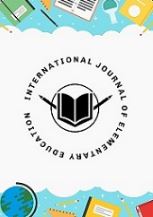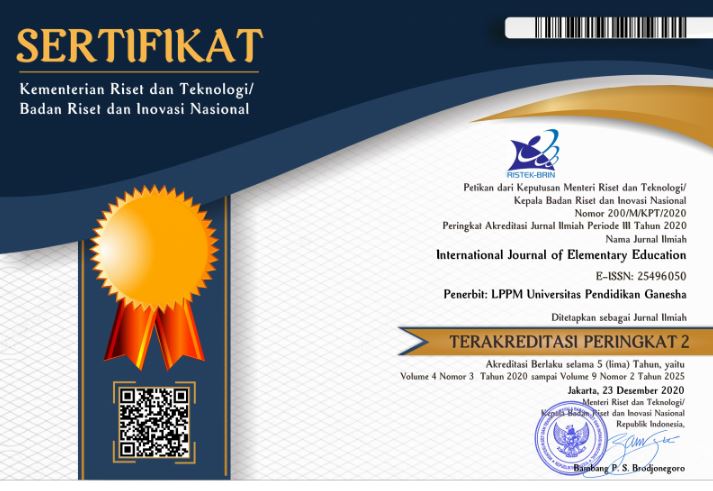Aquascape Media for Learning Ecosystem Materials in Elementary Schools
DOI:
https://doi.org/10.23887/ijee.v6i4.56098Keywords:
Media Aquascape, research and development, ecosystem materialAbstract
A Nowadays teacher has not been able to accommodate the media needs by the cognitive development of students. Good learning media that adapted to the characteristics of students is needed. Aquascape media is learning media that accordance with the characteristics of students at the stage of concrete operational cognitive development. The purpose of this study was to development of aquascape media in learning ecosystem materials. This research approach uses research and development which specifically describes the trial phase of this media development. The stage that will be the focus of the research is the aquascape media test on the media and material aspects. The questionnaire technique was used to collect data on the feasibility of media and aquascape materials. Analysis of the media and material expert questionnaire data was carried out using quantitative techniques. The results showed that the aquascape media that was developed was based on the assessment of two media experts from academics and practitioners, and obtained an average percentage score of 91.06%. The results of the assessment of material experts from academics and practitioners get an average percentage score of 95.53%. The appropriate test results from media and material experts are in the range of 81% to 100%, which means that the aquascape media is feasible and ready to be applied without the need for revision and the results of the effectiveness test showed that the pretest and posttest on the main field test showed that Aquascape media was effectively used in learning.
References
Agustini, K., Santyadiputra, G. S., & Sugihartini, N. (2020). Visualizing the stages of the educational research methodology into animation infographics for vocational students. Jurnal Pendidikan Vokasi, 9(3), 317–327. https://doi.org/10.21831/jpv.v9i3.22017.
Aji, S., Hudha, M., Huda, C., & Aini, Q. (2018). Problem-based learning in static fluid topic of physics module. 173(Icei 2017), 309–311. https://doi.org/10.2991/icei-17.2018.81.
Amali, L. N., Zees, N., & Suhada, S. (2020). Motion Graphic Animation Video As Alternative Learning Media. Jambura Journal of Informatics, 2(1). https://doi.org/10.37905/jji.v2i1.4640.
Antika, R. R. (2014). Proses Pembelajaran Berbasis Student Centered Learning (Studi Deskriptif di Sekolah Menengah Pertama Islam Baitul “Izzah, Nganjuk.” BioKultur, 3(1), 251. https://scholar.google.com/scholar?cites=5164642271972738619&as_sdt=2005&sciodt=0,5&hl=id.
Astuti, A. P., Aziz, A., Sumarti, S. S., & Bharati, D. A. L. (2019). Preparing 21st Century Teachers: Implementation of 4C Character’s Pre-Service Teacher through Teaching Practice. Journal of Physics: Conference Series, 1233(1). https://doi.org/10.1088/1742-6596/1233/1/012109.
Buchori, A. (2019). Pengembangan multimedia interaktif dengan pendekatan kontekstual untuk meningkatkan pemecahan masalah kemampuan matematika. Jurnal Inovasi Teknologi Pendidikan, 6(1), 104–115. https://doi.org/10.21831/jitp.v6i1.20094.
Fahmi, S., Priwantoro, S. W., Cahdriyana, R. A., Hendroanto, A., Rohmah, S. N., & Nisa, L. C. (2019). Interactive Learning Media Using Kvisoft Flipbook Maker for Mathematics Learning. Journal of Physics: Conference Series, 1188(1). https://doi.org/10.1088/1742-6596/1188/1/012075.
Hanifah, N. (2014). Memahami penelitian tindakan kelas: teori dan aplikasinya. Upi Press.
Hanisah, Irhasyuarna, Y., & Yulinda, R. (2022). Pengembangan Media Pembelajaran Interaktif menggunakan Ispring suite 10 pada Materi Reproduksi Tumbuhan untuk Mengukur Hasil Belajar. JUPEIS : Jurnal Pendidikan Dan Ilmu Sosial, 1(3), 6–16. https://doi.org/10.55784/jupeis.vol1.iss3.68.
Hasiru, D., Badu, S. Q., & Uno, H. B. (2021). Media-Media Pembelajaran Efektif dalam Membantu Pembelajaran Matematika Jarak Jauh. Jambura Journal of Mathematics Education, 2(2), 59–69. https://doi.org/10.34312/jmathedu.v2i2.10587.
Hutabarat, D. P., Susanto, R., Prasetya, B., Linando, B., & Arosha, S. M. N. (2022). Smart system for maintaining aquascape environment using internet of things based light and temperature controller. International Journal of Electrical and Computer Engineering, 12(1), 896–902. https://doi.org/10.11591/ijece.v12i1.pp896-902.
Java, G. E. S. P., Natsir, F., & Tama, B. J. (2021). Perancangan Aplikasi Penjualan Ikan Hias Pada Toko Aquascape di Depok Berbasis Android. Semnas Ristek (Seminar Nasional Riset Dan Inovasi Teknologi), 5(1), 187–193. https://doi.org/10.30998/semnasristek.v5i1.4888.
Juwantara, R. A. (2019). Analisis Teori Perkembangan Kognitif Piaget pada Tahap Anak Usia Operasional Konkret 7-12 Tahun dalam Pembelajaran Matematika. Al-Adzka: Jurnal Ilmiah Pendidikan Guru Madrasah Ibtidaiyah, 9(1), 27–34. https://doi.org/10.18592/aladzkapgmi.v9i1.3011.
Marinda, L. (2020). Teori Perkembangan Kognitif Jean Piaget dan Problematikanua pada Anak Usia Sekolah Dasar. An-Nisa’: Jurnal Kajian Perempuan Dan Keislaman, 13(1), 116–152. https://doi.org/10.35719/annisa.v13i1.26.
Masturah, E. D., Mahadewi, P. P., & Simamora, A. H. (2018). Pengembangan Media Pembelajaran Pop-Up Book pada Mata Pelajaran IPA Kelas III Sekolah Dasar. Jurnal EDUTECH Univrsitas Pendidikan Ganesha, 6(2), 212–221. https://doi.org/10.23887/jeu.v6i2.20294.
Mifroh, N. (2020). Teori Perkembangan Kognitif Jean Piaget dan Implementasinya dalam Pembelajaran di SD/MI. Jurnal Pendidikan Tematik (JPT), 1(3), 253–263. https://siducat.org/index.php/jpt/article/view/144.
Mustika, Z. (2015). Urgenitas Media Dalam Mendukung Proses Pembelajaran Yang Kondusif. CIRCUIT: Jurnal Ilmiah Pendidikan Teknik Elektro, 1(1), 60–73. https://doi.org/10.22373/crc.v1i1.311.
Nurochmah, A., Sutisnawati, A., & Wardana, A. E. (2019). Pengelolaan Satuan Pendidikan Dalam Rangka Mencetak Insan Generasi Muda Yang Unggul Di Sekolah Dasar. HOLISTIKA: Jurnal Ilmiah PGSD, III(2), 73–80. https://jurnal.umj.ac.id/index.php/holistika/article/view/5356.
Nurrita, T. (2018). Pengembangan Media Pembelajaran Untuk Meningkatkan Hasil Belajar Siswa. Jurnal Ilmu-Ilmu Al-Quran, Hadist, Syari’ah Dan Tarbiyah, 3(1), 171. https://lmsspada.kemdikbud.go.id/pluginfile.php/423559/mod_resource/content/2/Bahan bacaan.pdf.
Pratama, D. S., Ermiana, I., & Khair, B. N. (2022). Penerapan Media Miniatur Berbahan Dasar Kayu untuk Meningkatkan Hasil Belajar IPA Siswa Kelas IV SDN 2 Dasan Geria. Jurnal Ilmiah Profesi Pendidikan, 7(2), 368–373. https://doi.org/10.29303/jipp.v7i2.477.
Qorinasari, D. (2020). Peningkatan Hasil Belajar Tematik Tema 4 Subtema 1 Pembelajaran 1 Melalui Penggunaan Media Video Animasi Pada Peserta Didik Kelas 1 Sd Negeri Polokarto 03 Kabupaten Sukoharjo Tahun Pelajaran 2020/2021. JP3 (Jurnal Pendidikan Dan Profesi Pendidik), 6(2), 168–176. https://doi.org/10.26877/jp3.v6i2.7321.
Rachmadtullah, R., Yustitia, V., Setiawan, B., Fanny, A. M., Pramulia, P., Susiloningsih, W., Rosidah, C. T., Prastyo, D., & Ardhian, T. (2020). The Challenge of Elementary School Teachers to Encounter Superior Generation in the 4.0 Industrial Revolution: Study Literature. International Journal of Scientific and Technology Research, 9(4), 1879–1882. https://www.researchgate.net/profile/Reza-Rachmadtullah/publication/340886839_The_Challenge_Of_Elementary_School_Teachers_To_Encounter_Superior_Generation_In_The_40_Industrial_Revolution_Study_Literature/links/5ea2b9a492851c87d1b1066f/The-Challenge-Of-Ele.
Raharjo, S., Kurniawan, E., & Nurcahya, E. D. (2018). Sistem Otomatisasi Fotosintesis Buatan Pada Aquascape Berbasis Arduino. Komputek, 2(1), 39. https://doi.org/10.24269/jkt.v2i1.66.
Ramadhila, R., Gamal, R., & Kusumah, T. (2022). Pengembangan Aquascape Mini Ekosistem Sebagai Media. Insan Cendikia, 1(1), 1–7. https://ejournal-insancendekia.com/index.php/HOME/article/view/3.
Rejekiningsih, T., Budiarto, M. K., & Sudiyanto, S. (2021). Pengembangan Multimedia Interaktif Berbasis Potensi Lokal Untuk Pembelajaran Prakarya Dan Kewirausahaan Di SMA. Kwangsan: Jurnal Teknologi Pendidikan, 9(2), 167. https://doi.org/10.31800/jtp.kw.v9n2.p167--185.
Rosalina, S. S., & Suhardi, A. (2020). Need Analysis of Interactive Multimedia Development With Contextual Approach on Pollution Material. INSECTA: Integrative Science Education and Teaching Activity Journal, 1(1), 93. https://doi.org/10.21154/insecta.v1i1.2107.
Setyowati, F., & Mintohari. (2020). Pengembangan Media Miniatur Kereta Api pada Materi Sistem Peredaran Darah Manusia Pembelajaran IPA SD Kelas V. Jurnal Penelitian Pendidikan Guru Sekolah Dasar, 8, 100–110. https://jurnalmahasiswa.unesa.ac.id/index.php/39/article/view/33522.
Suniyasih, N. M., Ratminingsih, N. M., & Budasi, I. G. (2020). Development of Multilingual Thematic Picture Dictionary: A Support for Literacy. Jurnal Pendidikan Dan Pengajaran, 53(3), 236. https://doi.org/10.23887/jpp.v53i3.27508.
Suryansah, T., & Suwarjo, S. (2016). Pengembangan Video Pembelajaran Untuk Meningkatkan Motivasi Dan Hasil Belajar Kognitif Siswa Kelas Iv Sd. Jurnal Prima Edukasia, 4(2), 209. https://doi.org/10.21831/jpe.v4i2.8393.
Susanto, A., Sujalwo, & Sukirman. (2019). Media Pembelajaran Berbasis Game Menggunakan Construct 2 untuk Pengenalan Bentuk Angka dan Huruf pada Siswa PAUD. 22–46. http://eprints.ums.ac.id/id/eprint/71227.
Sutabri, T., Widodo, Y. B., Sibuea, S., Rajiani, I., & Hasan, Y. (2019). Tankmate Design for Settings Filter, Temperature, and Light on Aquascape. Journal of Southwest Jiaotong University, 54(5). https://doi.org/10.35741/issn.0258-2724.54.5.45.
Tegeh, I. M., & Kirna, I. M. (2013). Pengembangan Bahan Ajar Metode Penelitian Pendidikan dengan ADDIE Model. Jurnal IKA, 11(1), 16. https://doi.org/10.23887/ika.v11i1.1145.
Trinova, Z. (2003). Pembelajaran Berbasis Student-Centered Learning. Jurnal Al-Ta’lim, 1(4), 324–335. https://doi.org/10.15548/jt.v20i1.28.
Wisada, P. D., Sudarma, I. K., & Yuda S, A. I. W. I. (2019). Pengembangan Media Video Pembelajaran Berorientasi Pendidikan Karakter. Journal of Education Technology, 3(3), 140. https://doi.org/10.23887/jet.v3i3.21735.
Yu, T. X., & Wan Mohammad, W. M. R. (2019). Integration of 21st Century Learning Skills (4C Elements) in Interventions to Improve English Writing Skill Among 3K Class Students. International Journal of Contemporary Education, 2(2), 100. https://doi.org/10.11114/ijce.v2i2.4498.
Yuliana, N. D., & Budianti, Y. (2015). Pengaruh penggunaan media konkret terhadap hasil belajar siswa pada mata pelajaran matematika kelas II Sekolah Dasar Negeri Babelan Kota 06 Kecamatan Babelan Kabupaten Bekasi. Pedagogik, 3(1), 34–40. https://doi.org/10.33558/pedagogik.v3i1.1258.
Downloads
Published
How to Cite
Issue
Section
License
Copyright (c) 2022 Wahyu Cahyo Laksono, Sumardi, Ahmad Muhibbidin, Yenny Prastiwi, Laili Etika Rahmawati

This work is licensed under a Creative Commons Attribution-ShareAlike 4.0 International License.
Authors who publish with the International Journal of Elementary Education agree to the following terms:
- Authors retain copyright and grant the journal the right of first publication with the work simultaneously licensed under a Creative Commons Attribution License (CC BY-SA 4.0) that allows others to share the work with an acknowledgment of the work's authorship and initial publication in this journal.
- Authors are able to enter into separate, additional contractual arrangements for the non-exclusive distribution of the journal's published version of the work (e.g., post it to an institutional repository or publish it in a book), with an acknowledgment of its initial publication in this journal.
- Authors are permitted and encouraged to post their work online (e.g., in institutional repositories or on their website) prior to and during the submission process, as it can lead to productive exchanges, as well as earlier and greater citation of published work. (See The Effect of Open Access)









